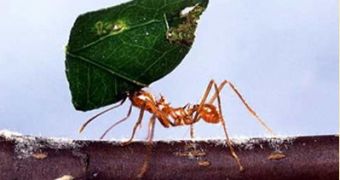We go to the doctor to have a baby when we decide we want one. And the new techniques also detect the sex of our embryo baby and eventual genetic diseases. But animals cannot appeal to technologies and they still need a way of regularizing their populations. That's especially important in the case of the species that live in colonies.
Now a team from University of Leeds has found a flexible gene in leaf-cutting ants enabling them to breed the optimum numbers of each worker type needed to ensure the smooth running of the colony.
The larvae posses a genetic pattern to develop into a particular worker caste, but environmental factors can shift this growth linked to colony's workforce needs.
"Our previous research suggested that genetics did indeed play a part in caste determination - but not how much of a part.
This left us with a conundrum: ant colonies are a model of social efficiency, yet if genetics ruled caste development, then this would be a very rigid - and therefore very inefficient - method of ensuring an optimum workforce balance," said evolutionary biologist Dr William Hughes of the Faculty of Biological Sciences.
"It seems that ants have evolved their own solution to this problem. Given that it takes an ant eight weeks to develop from an egg into an adult, ant colonies have to predict the need for different types of worker well in advance, and a flexible combination of nature and nurture will help them do this."
The research was made on the leaf-cutting ants named Acromyrmex, which present two distinct worker castes: large workers, involved in foraging and building the nest and small workers, which cultivate the fungus eaten by the ants and care for the larvae.
Like in all social insects, workers are always female and the large workers are thrice as big as the smaller ones. The workers cut off leaves, chop them to pieces and bring them to the nest, where on the rotting leaf pieces the fungi are cultivated. The queen ants mate with various males, so that the only difference between worker castes within a colony is determined by different genes transmitted by their different fathers.
To check the stiffness of this genetic condition, all large workers were removed from a colony, leaving a need for more larvae to grow into this type of workers.
The researchers discovered that larvae carrying genes for small workers developed into large workers, thus proving that these genes are adaptable.
Leaf-cutting ants can be considered a severe pest for several crops in tropical America. They particularly enjoy citrus and Eucalyptus trees and one colony of the Atta can leave a tree completely defoliated in just one night and in some tropical forests they can cut and carry into their nests 17 % of leaf mass. More knowledge about their biology could lead to the development of methods of controlling them.
"We don't yet know what environmental cues influence the caste destiny of the larvae - it could be the food they're fed, the temperature, or even pheromones," said Hughes.

 14 DAY TRIAL //
14 DAY TRIAL //